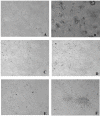Detection of Avian Reoviruses in Wild Birds in Poland
- PMID: 29978079
- PMCID: PMC5894429
- DOI: 10.1515/jvetres-2017-0033
Detection of Avian Reoviruses in Wild Birds in Poland
Abstract
Introduction: The purpose of this study was to determine the occurrence of avian reovirus (ARV) infections in wild birds in Poland and attempt to propagate the selected ARV strains in chicken embryo kidney (CEK) cells or chicken SPF embryos.
Material and methods: The study included 192 wild birds representing 32 species, collected between 2014 and 2016. A part of the S4 segment encoding the σNS protein of avian reoviruses (ARVs) isolated from different species of wild birds from that period was amplified.
Results: The presence of ARV was demonstrated in 58 (30.2%) wild birds belonging to nine orders. The isolated strains were propagated in chicken embryos by yolk sac inoculation, and CPE was induced in the infected CEK monolayer. Agar gel precipitation showed that two ARV isolates from rock pigeon and mute swan shared a common group-specific antigen with chicken reovirus S1133. Specific products of predicted size were found in two ARV isolates from the chicken embryo passage and 13 ARVs isolated from CEK cells.
Conclusion: The study indicates the high prevalence of ARV among wild birds in Poland and its possible transmission to farmed birds.
Keywords: Poland; avian reovirus; wild birds.
Conflict of interest statement
Conflict of Interests Statement: The authors declare that they there is no conflict of interests regarding the publication of this article. Financial Disclosure Statement: The study was supported by Project KNOW No. K/02/0.1 “New molecular methods for diagnosis of poultry viral diseases”. Animal Rights Statement: None required.
Figures


Similar articles
-
Isolation and Genomic Characterization of Avian Reovirus From Wild Birds in South Korea.Front Vet Sci. 2022 Jan 28;9:794934. doi: 10.3389/fvets.2022.794934. eCollection 2022. Front Vet Sci. 2022. PMID: 35155656 Free PMC article.
-
Avian Reoviruses From Wild Birds Exhibit Pathogenicity to Specific Pathogen Free Chickens by Footpad Route.Front Vet Sci. 2022 Feb 24;9:844903. doi: 10.3389/fvets.2022.844903. eCollection 2022. Front Vet Sci. 2022. PMID: 35280152 Free PMC article.
-
Occurrence of Reovirus (ARV) Infections in Poultry Flocks in Poland in 2010-2017.J Vet Res. 2018 Dec 31;62(4):421-426. doi: 10.2478/jvetres-2018-0079. eCollection 2018 Dec. J Vet Res. 2018. PMID: 30729197 Free PMC article.
-
Antibody responses against avian reovirus nonstructural protein sigmaNS in experimentally virus-infected chickens monitored by a monoclonal antibody capture enzyme-linked immunosorbent assay.Res Vet Sci. 2004 Jun;76(3):219-25. doi: 10.1016/j.rvsc.2003.11.001. Res Vet Sci. 2004. PMID: 15046956
-
Phylogenetic Analysis and Pathogenicity of Avian Reoviruses Isolated from Viral Arthritis Cases in China 2010-2024.Vet Sci. 2025 Mar 28;12(4):307. doi: 10.3390/vetsci12040307. Vet Sci. 2025. PMID: 40284810 Free PMC article.
Cited by
-
Detection and Identification of Avian Reovirus in Young Geese (Anser anser domestica) in Poland.Animals (Basel). 2022 Nov 29;12(23):3346. doi: 10.3390/ani12233346. Animals (Basel). 2022. PMID: 36496863 Free PMC article.
-
Isolation and Genomic Characterization of Avian Reovirus From Wild Birds in South Korea.Front Vet Sci. 2022 Jan 28;9:794934. doi: 10.3389/fvets.2022.794934. eCollection 2022. Front Vet Sci. 2022. PMID: 35155656 Free PMC article.
-
Whole Genomic Constellation of Avian Reovirus Strains Isolated from Broilers with Arthritis in North Carolina, USA.Viruses. 2023 Oct 31;15(11):2191. doi: 10.3390/v15112191. Viruses. 2023. PMID: 38005869 Free PMC article.
-
Serological detection of avian reovirus in different poultry flocks of Gazipur and Mymensingh districts of Bangladesh.Vet World. 2019 Jul;12(7):1126-1131. doi: 10.14202/vetworld.2019.1126-1131. Epub 2019 Jul 26. Vet World. 2019. PMID: 31528043 Free PMC article.
-
Avian Reoviruses From Wild Birds Exhibit Pathogenicity to Specific Pathogen Free Chickens by Footpad Route.Front Vet Sci. 2022 Feb 24;9:844903. doi: 10.3389/fvets.2022.844903. eCollection 2022. Front Vet Sci. 2022. PMID: 35280152 Free PMC article.
References
-
- Bányai K., Dandár E., Dorsey K.M., Mató T., Palya V.. The genomic constellation of a novel avian orthoreovirus strain associated with runting-stunting syndrome in broilers. Virus Genes. 2011;42:82–89. - PubMed
-
- Benavente J., Martínez-Costas J.. Avian reovirus: structure and biology. Virus Res. 2007;123:105–119. - PubMed
-
- Bruhn S., Bruckner L., Ottiger H.P.. Application of RT-PCR for the detection of avian reovirus contamination in avian viral vaccines. J Virol Methods. 2005;123:179–186. - PubMed
-
- Hollmen T., Docherty D.E. Thomas N.C., Hunter D.B., Atkinson C.T. Infectious Diseases of Wild Birds. Blackwell Publishing; Iowa, USA: 2007. Orthoreovirus; pp. 177–181.
LinkOut - more resources
Full Text Sources
Other Literature Sources
Research Materials
Miscellaneous
